The Behavior of Polyurethane Foam-Filled Glass-Fiber-Reinforced Polymer Crossarm Subjected to Lightning Transient Voltage
Abstract
:1. Introduction
2. Materials and Methods
2.1. Experimental Work
2.2. Finite Elements Simulation
3. Results and Discussion
3.1. Critical Flashover Voltage
3.2. FEM Analyses
4. Conclusions
Author Contributions
Funding
Institutional Review Board Statement
Informed Consent Statement
Data Availability Statement
Acknowledgments
Conflicts of Interest
References
- Rawi, I.M.; Abd Rahman, M.S.; Ab Kadir, M.Z.A.; Izadi, M. Wood and fiberglass crossarm performance against lightning strikes on transmission towers. In Proceedings of the International Conference on Power System, Seoul, Korea, 26–29 June 2017; pp. 1–6. [Google Scholar]
- Yang, B.; Zhang, J.; Zhou, L.; Lu, M.; Liang, W.; Wang, Z. Effect of fiber surface modification on water absorption and hydrothermal aging behaviors of GF/pCBT composites. Compos. Part B 2015, 82, 84–91. [Google Scholar] [CrossRef]
- Mlyniec, A.; Korta, J.; Kudelski, R.; Uhl, T. The influence of the laminate thickness, stacking sequence and thermal aging on the static and dynamic behavior of carbon/epoxy composites. Compo. Struct. 2014, 118, 208–216. [Google Scholar] [CrossRef]
- Shao, J.; Wang, J.; Long, M.; Li, J.; Ma, Y. 5000 h multi-factor accelerated aging test of frp made transmission tower: Characterization, thermal decomposition and reaction kinetics study. Polymers 2017, 9, 170. [Google Scholar] [CrossRef] [Green Version]
- Asyraf, M.R.M.; Ishak, M.R.; Sapuan, S.M.; Yidris, N. Utilization of Bracing Arms as Additional Reinforcement in Pultruded Glass Fiber-Reinforced Polymer Composite Cross-Arms: Creep Experimental and Numerical Analyses. Polymers 2021, 13, 620. [Google Scholar] [CrossRef]
- Mohamad, D.; Syamsir, A.; Beddu, S.; Abas, A.; Ng, F.; Razali, M.; Seman, S.A.H.A. Numerical study of composite fiberglass cross arms under statics loading and improvement with sleeve installation. IOP Conf. Ser. Mater. Sci. Eng. 2019, 530, 012027. [Google Scholar] [CrossRef]
- Sá, M.F.; Gomes, A.M.; Correia, J.R.; Silvestre, N. Creep behavior of pultruded GFRP elements–Part 1: Literature review and experimental study. Compos. Struct. 2011, 93, 2450–2459. [Google Scholar] [CrossRef]
- Xin, H.; Liu, Y.; Mosallam, A.S.; He, J.; Du, A. Evaluation on material behaviors of pultruded glass fiber reinforced polymer (GFRP) laminates. Compos. Struct. 2017, 182, 283–300. [Google Scholar] [CrossRef] [Green Version]
- Britt, W.F., Jr. Composite Structural Support Arm. U.S. Patent 9790704 B2, 17 January 2017. [Google Scholar]
- Pieper, R.J. The use of mechanical testing, photomicrography an electron microscopy to characterize an insulating fiberglass composite post-electrical arc failure. Microsc. Microanal. 2016, 22, 1830–1831. [Google Scholar] [CrossRef] [Green Version]
- Grzybowski, S. Electrical performance of 115 kV transmission lines fiberglass crossarms aged in field. In Proceedings of the 5th International Conference on Properties and Applications of Dielectric Materials, Seoul, Korea, 25–30 May 1997; pp. 774–777. [Google Scholar]
- Grzybowski, S.; Disyadej, T. Electrical performance of fiberglass crossarm in distribution and transmission lines. In Proceedings of the 2008 IEEE/PES Transmission and Distribution Conference and Exposition, Bogota, Columbia, 21–24 April 2008; pp. 1–5. [Google Scholar]
- Laninga, J.; Amer, M.; Swatek, D.; McDermid, W.; Kordi, B. HVDC flashover performance of fibreglass reinforced (FRP) hot sticks considering space charges. In Proceedings of the 2017 IEEE Conference on Electrical Insulation and Dielectric Phenomenon (CEIDP), Fort Worth, TX, USA, 22–25 October 2017; pp. 609–612. [Google Scholar]
- Karady, G.G.; Argin, M.; Shi, B.; Rahmatian, F.; Rose, A.H. Electrical properties of rigid pour polyurethane foam applied for high voltage insulation. In Proceedings of the 2003 IEEE PES Transmission and Distribution Conference and Exposition (IEEE Cat. No. 03CH37495), Dallas, TX, USA, 7–12 September 2003; pp. 870–874. [Google Scholar]
- Strauchs, A.; Mashkin, A.; Schnettler, A.; Podlazly, J.; Freiheit-Jensen, B. Investigations on the partial discharge behavior of syntactic foam under uniform field stress. In Proceedings of the IEEE International Symposium on Electrical Insulation, San Diego, CA, USA, 6–9 June 2010; pp. 1–5. [Google Scholar]
- Abd Rahman, M.S.; Ab Kadir, M.Z.A.; Ab-Rahman, M.; Osman, M.; Nor, S.F.M. Lightning impulse strength of 275 kV and 132 kV Tower with composite crossarm. In Proceedings of the 11th Asia-Pacific International Conference on Lightning (APL), Hong Kong, China, 12–14 June 2019; pp. 1–6. [Google Scholar]
- Abd Rahman, M.S.; Ab Kadir, M.Z.A.; Ab-Rahman, M.; Osman, M.; Nor, S.F.M.; Mohd Zainuddin, N. Effects of a Crossarm Brace Application on a 275 kV Fiberglass-Reinforced Polymer Crossarm Subjected to a Lightning Impulse. Energies 2020, 13, 6248. [Google Scholar] [CrossRef]
- Jahangiri, T.; Wang, Q.; Bak, C.L.; da Silva, F.F.; Skouboe, H. Electric stress computations for designing a novel unibody composite cross-arm using finite element method. IEEE Trans. Dielectr. Electr. Insul. 2017, 24, 3567–3577. [Google Scholar] [CrossRef]
- Shanmugam, G.; Karakkad, S. Influence of the insulator geometry on the streamer propagation characteristics in polymeric insulators under positive polarity lightning impulse voltages. IET Sci. Meas. Technol. 2018, 12, 1082–1088. [Google Scholar] [CrossRef]
- Zachariades, C.; Rowland, S.M.; Cotton, I.; Peesapati, V.; Chambers, D. Development of electric-field stress control devices for a 132 kV insulating cross-arm using finite-element analysis. IEEE Trans. Power Deliv. 2015, 31, 2105–2113. [Google Scholar] [CrossRef]
- Rosli, A.N. Numerical Modelling of Glass Fiber Reinforced Polymer (GFRP) Crossarm in Transmission Tower Subjected to Static Loading. Master’s Dissertation, Universiti Tenaga Nasional, Kajang, Malaysia, 2020. [Google Scholar]
- IEC60060-1: High Voltage Test Techniques—Part 1: General Definition and Test Requirements; International Electrotechnical Commission: Geneva, Switzerland, 2010.
- Tuncer, E.; Sauers, I.; James, D.R.; Ellis, A.R. Electrical insulation characteristics of glass fiber reinforced resins. IEEE Trans. Appl. Supercond. 2009, 19, 2359–2362. [Google Scholar] [CrossRef]
- Yamano, Y.; Takahashi, M.; Kobayashi, S.; Hanada, M.; Ikeda, Y. Surface discharge related properties of fiberglass reinforced plastic insulator for use in neutral beam injector of JT-60U. Rev. Sci. Instrum. 2008, 79, 02A524. [Google Scholar] [CrossRef] [Green Version]
- Liang, X.; Shen, Y.; Liu, Y.; Wang, J.; Gao, Y.; Li, S.; Wang, M.; Gao, S. Investigations on the basic electrical properties of Polyurethane foam material. In Proceedings of the 2015 IEEE 11th International Conference on the Properties and Applications of Dielectric Materials (ICPADM), Sydney, Australia, 19–22 July 2015; pp. 863–866. [Google Scholar]
- Huang, D.; Ruan, J.; Chen, Y.; Huo, F.; Yu, S.; Liu, S. Calculation and measurement of potential and electric field distribution along 1000 kV AC transmission line composite insulator. In Proceedings of the ICEMS 2008: International Conference on Electrical Machines and Systems, Wuhan, China, 17–20 October 2008; pp. 428–433. [Google Scholar]
- Yang, X.; Wang, Q.; Wang, H.; Zhang, S.; Peng, Z. Transient electric field computation for composite cross-arm in 750 kV AC transmission line under lightning impulse voltage. IEEE Trans. Dielectr. Electr. Insul. 2016, 23, 1942–1950. [Google Scholar] [CrossRef]
- Ryan, H.M. Fundamental aspects of air breakdown. In High Voltage Engineering and Testing, 3rd ed.; The Institution of Engineering and Technology: London, UK, 2013; pp. 631–674. [Google Scholar]
- Shanmugam, G.; Samajdar, G.; Karakkad, S. Surface Charging and its Influence on Lightning Impulse Flashover Characteristics of Polymeric Insulator. In Proceedings of the 2019 IEEE International Conference on Electrical, Computer and Communication Technologies (ICECCT), Tamil Nadu, India, 20–22 February 2019; pp. 1–5. [Google Scholar]
- Thione, L.; Pigini, A.; Allen, N.; Aro, M.; Baker, A. Guidelines for the Evaluation of the Dielectric Strength of External Insulation; CIGRE Brochure: Paris, France, 1992. [Google Scholar]
- Liu, L.; Becerra, M. An efficient model to simulate stable glow corona discharges and their transition into streamers. J. Phys. D Appl. Phys. 2017, 50, 105204. [Google Scholar] [CrossRef]
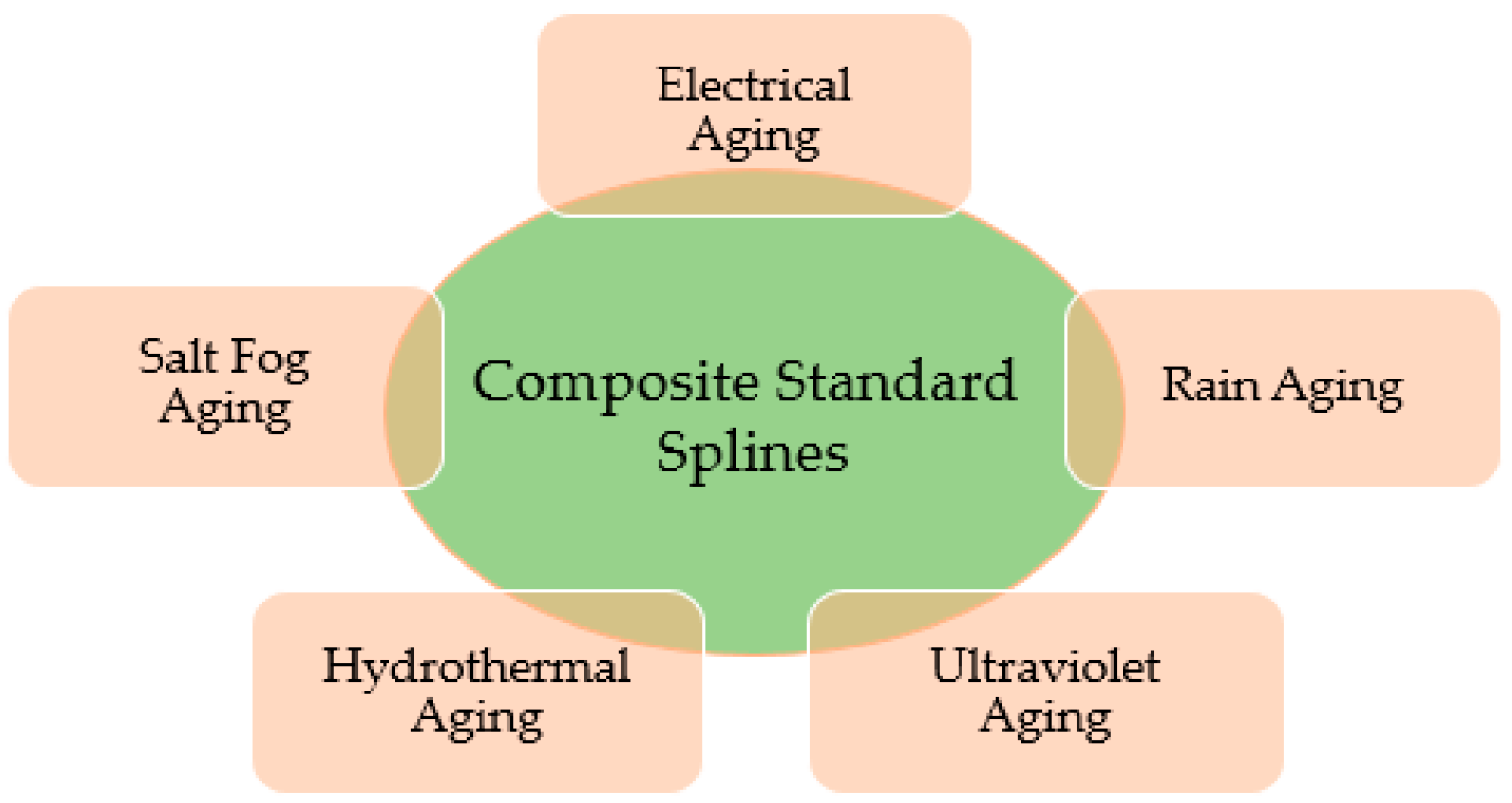
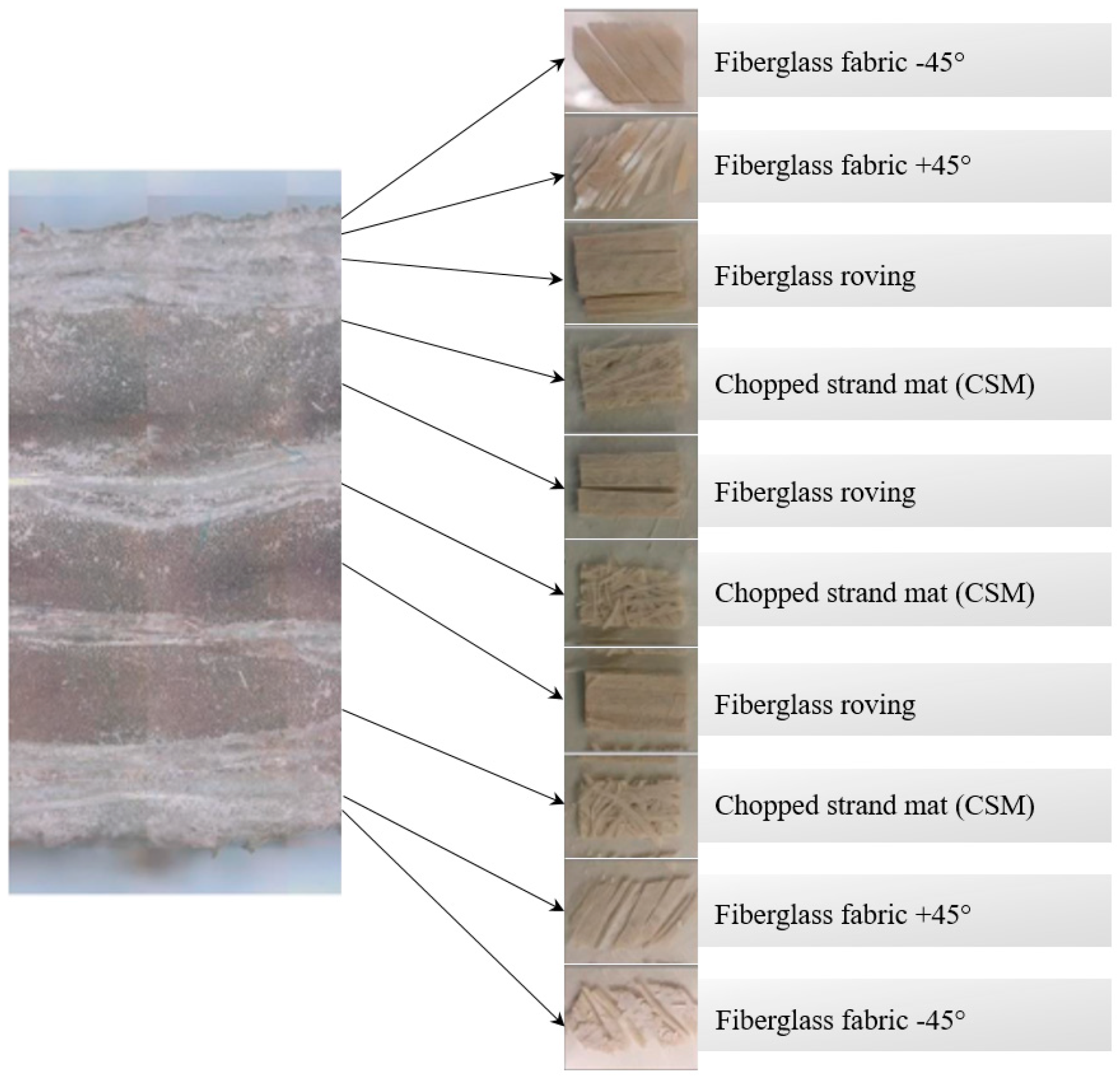
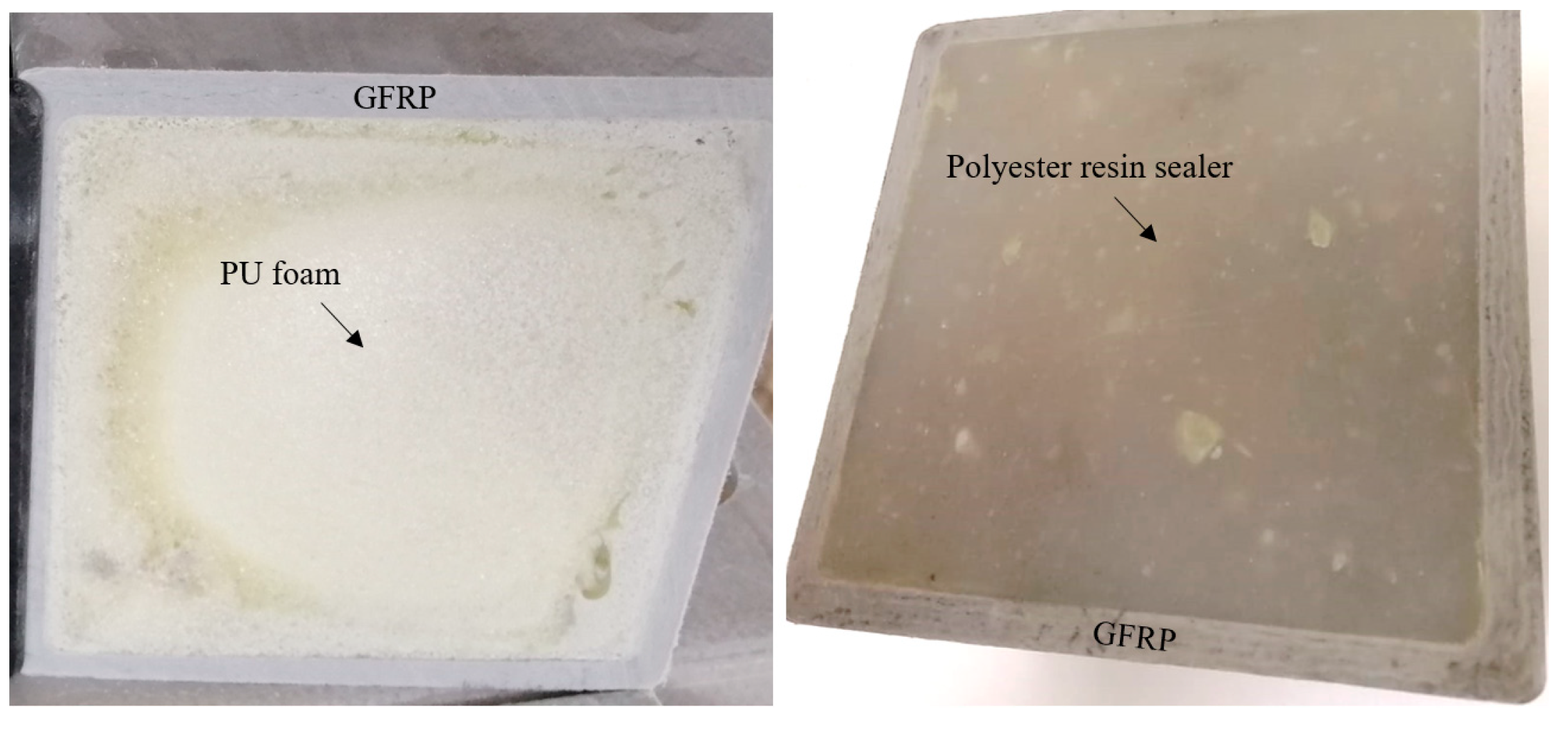
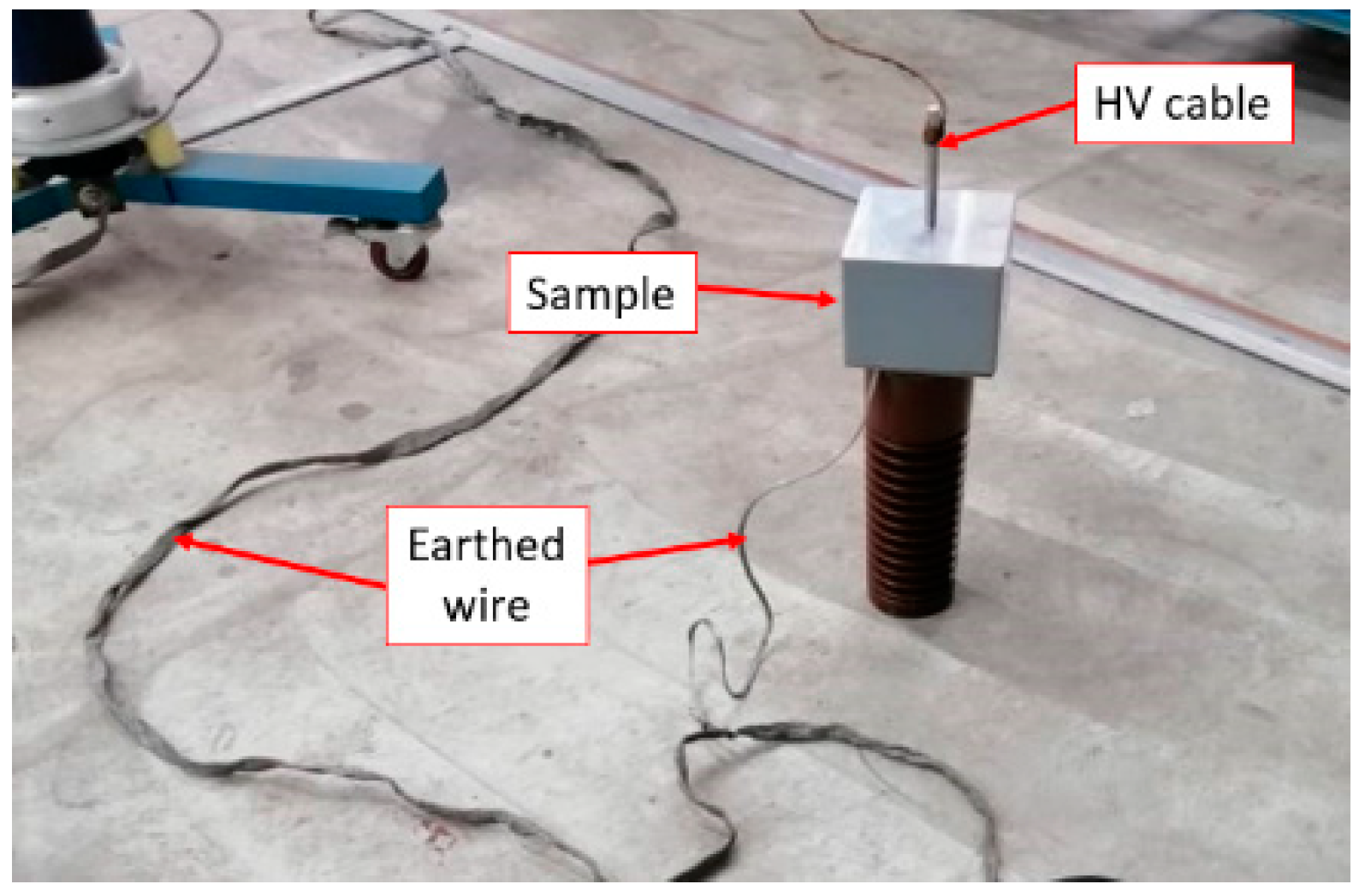
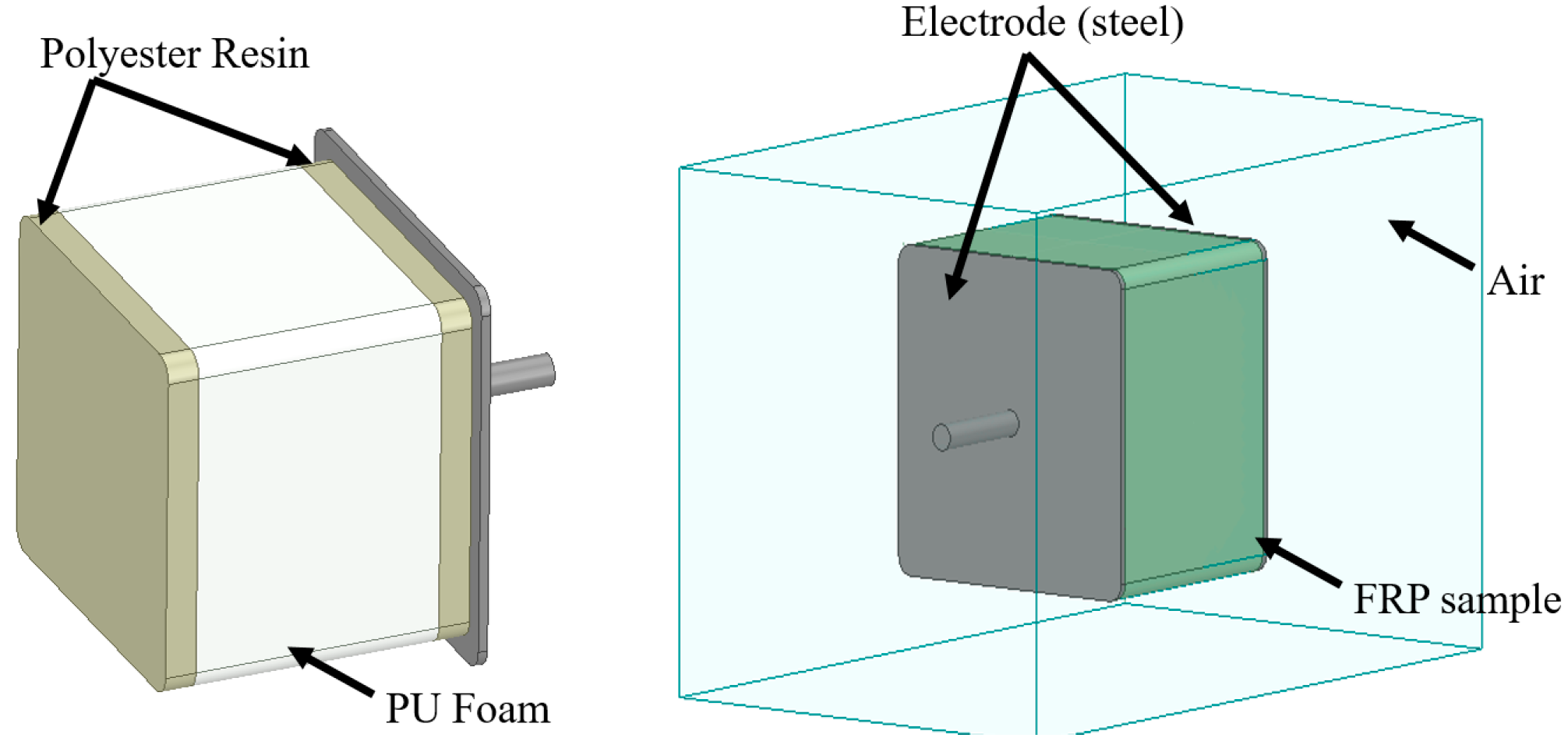
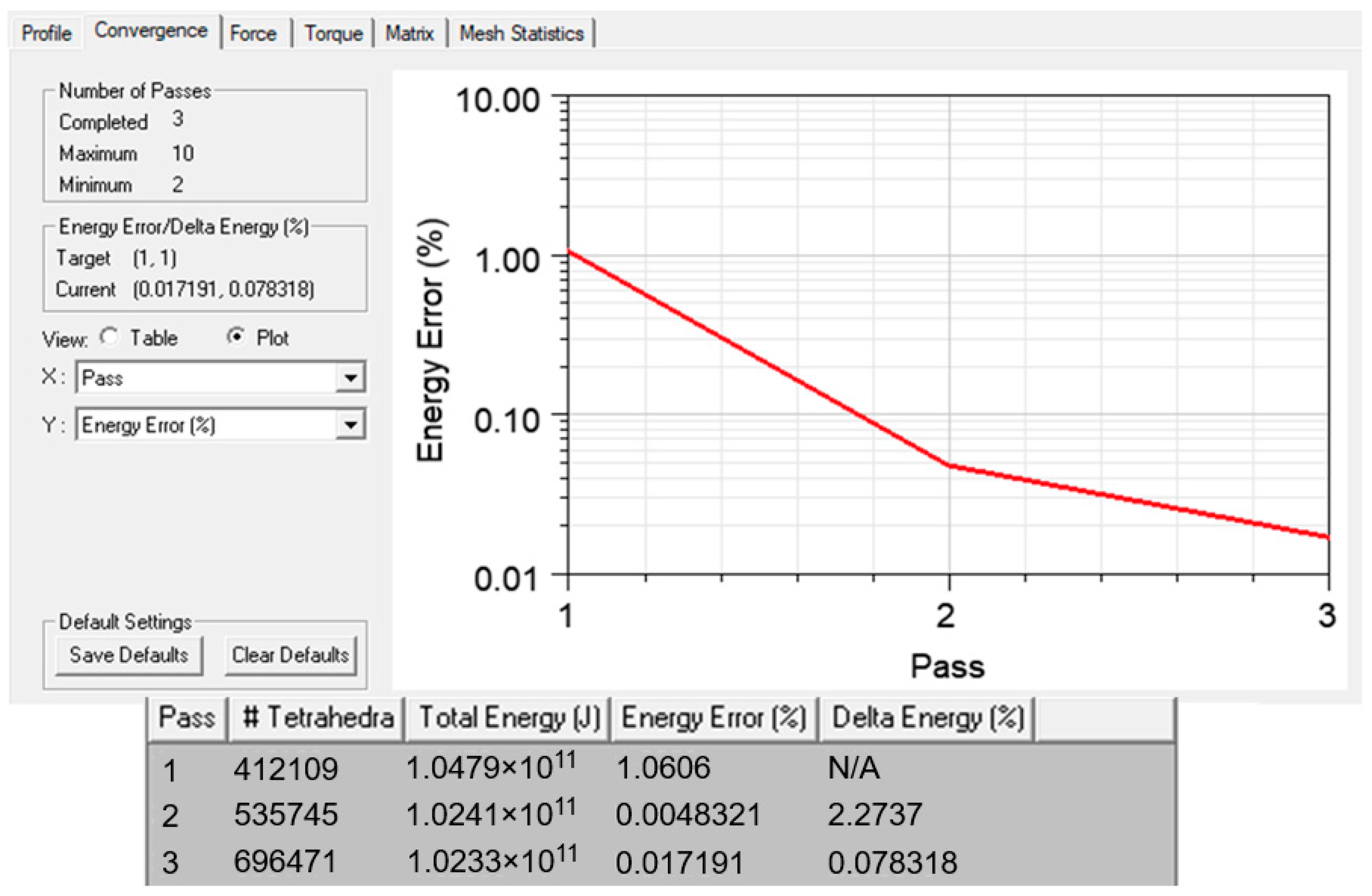
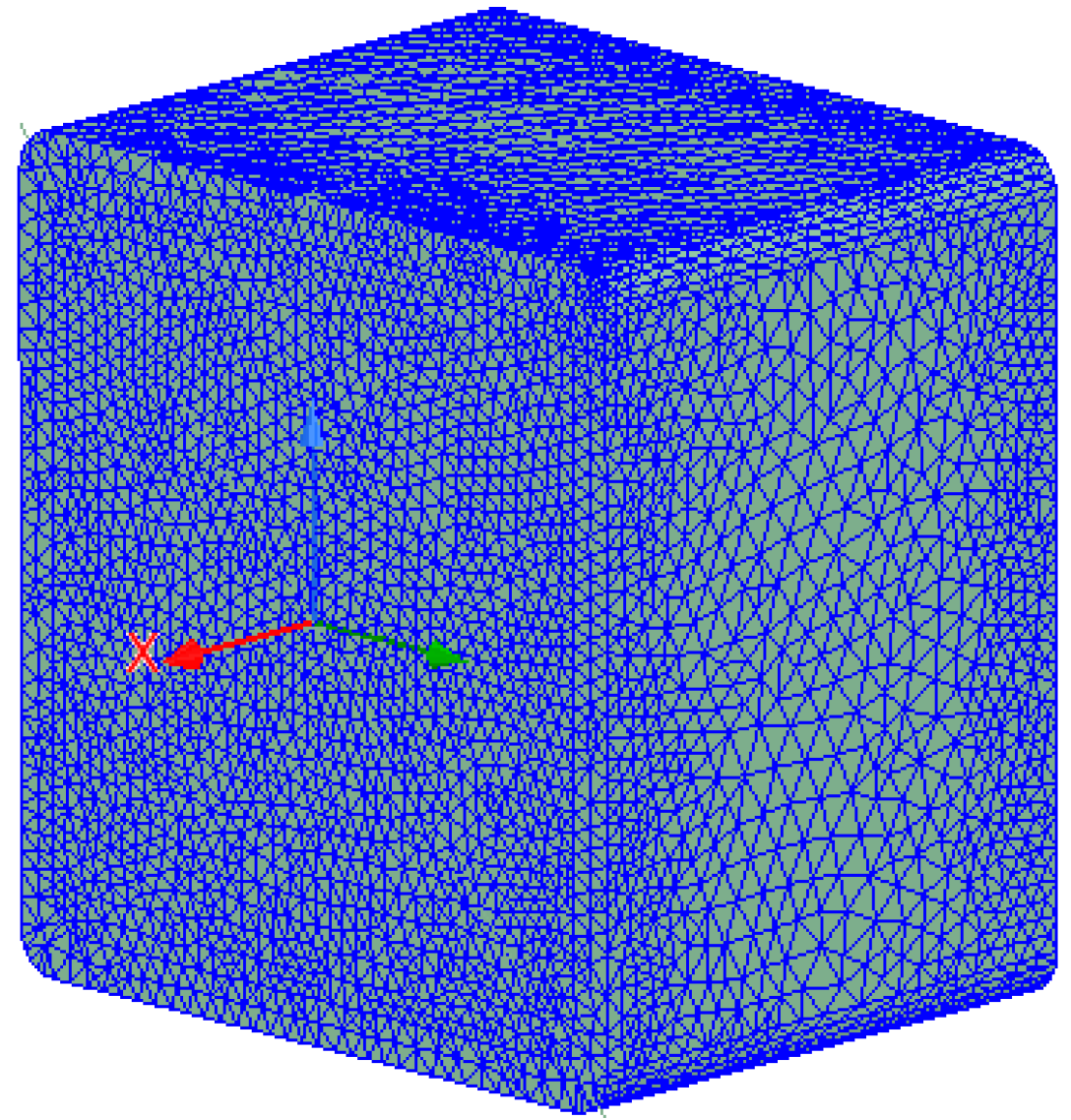

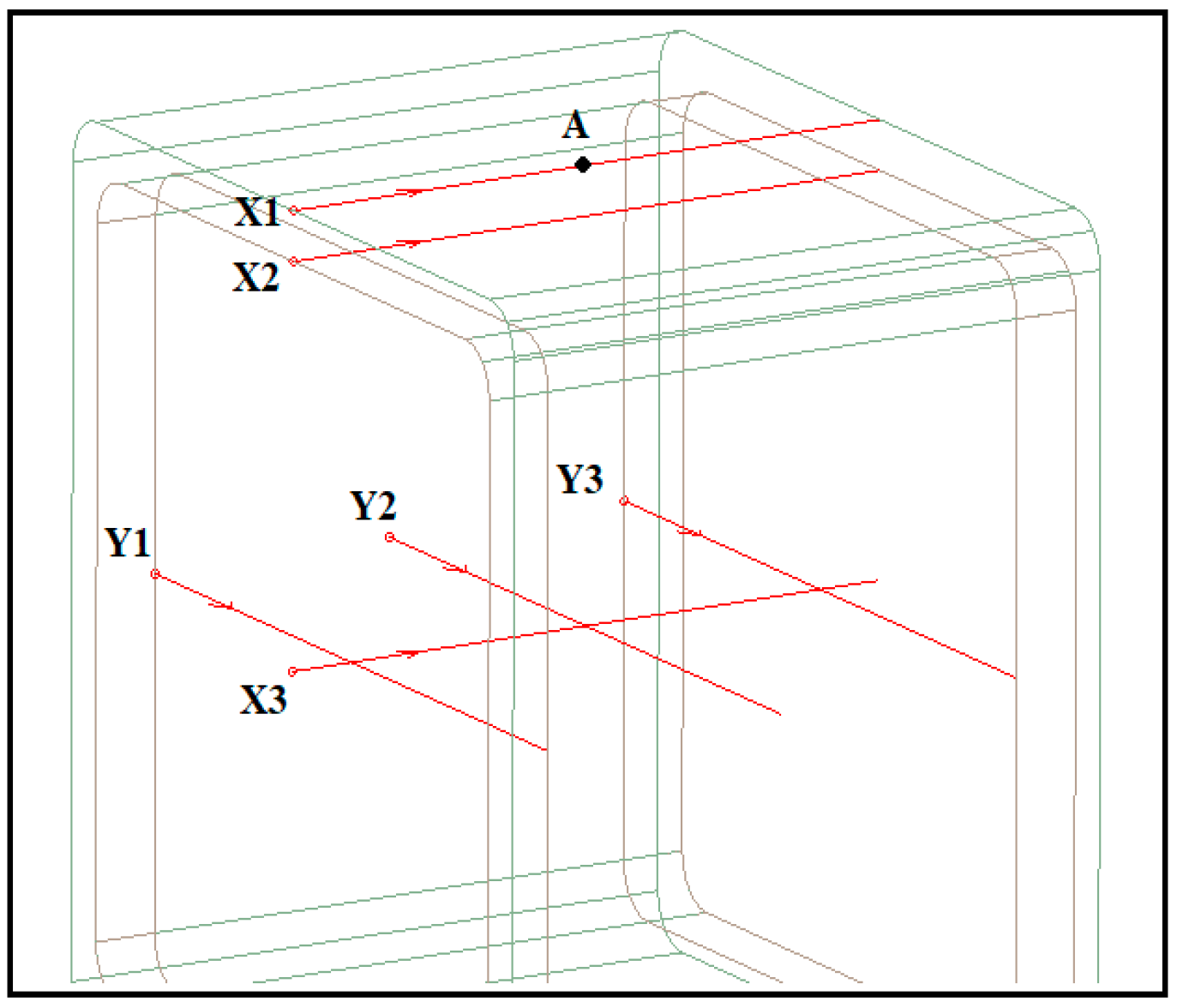
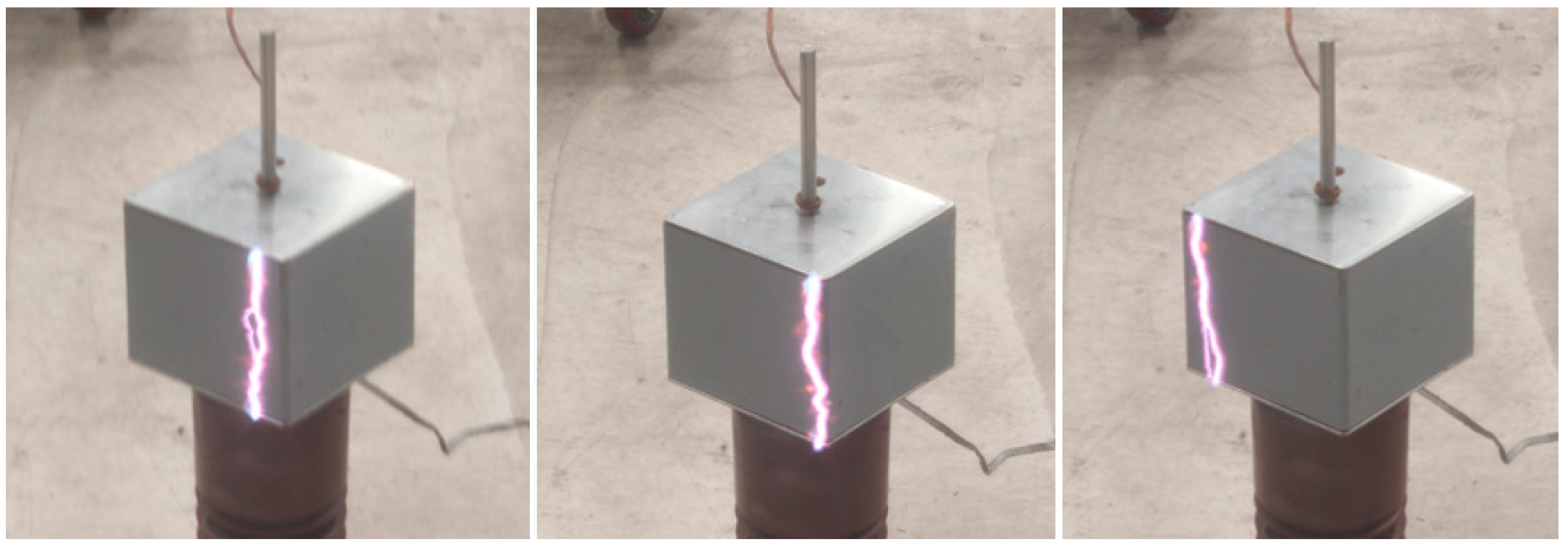
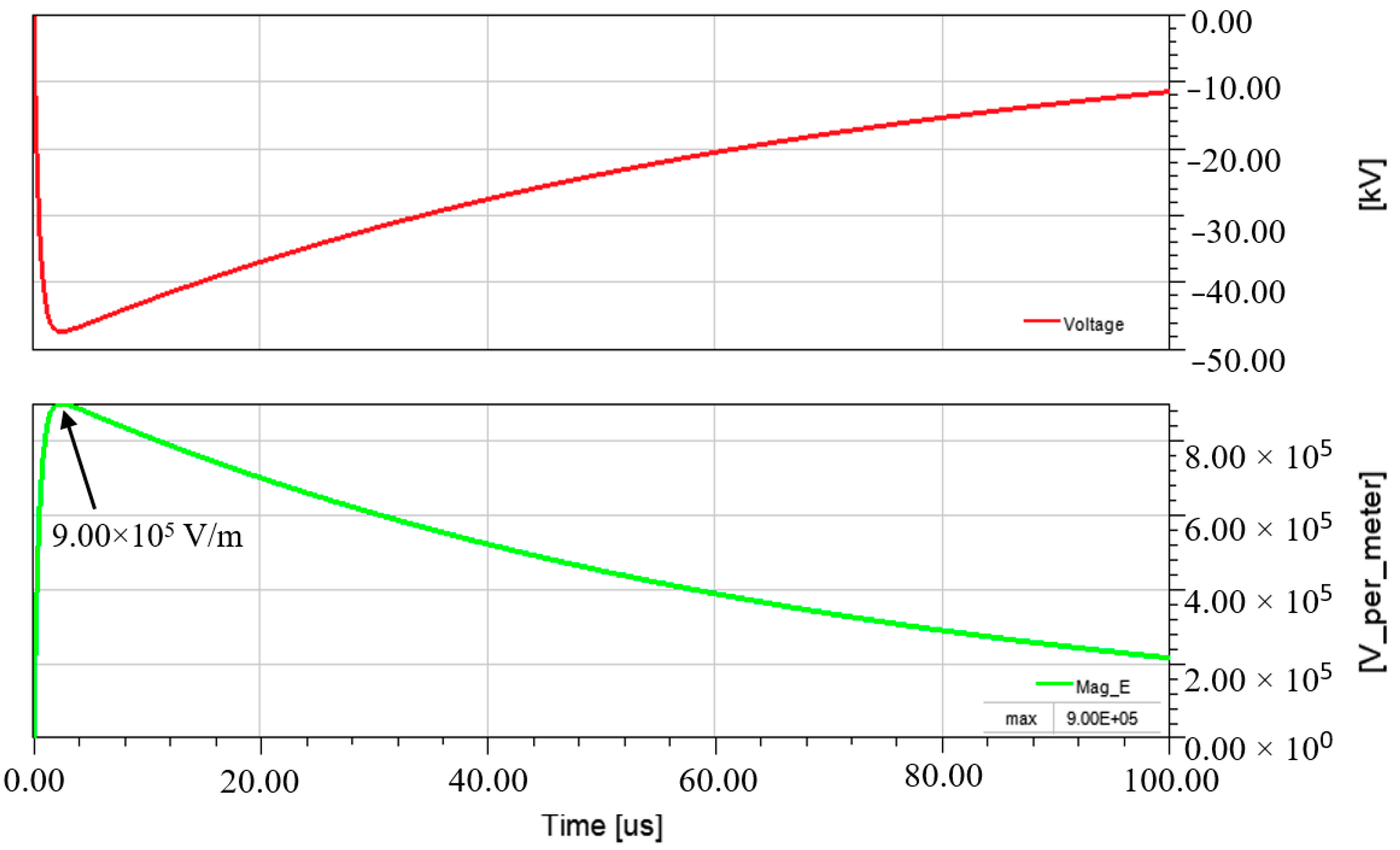
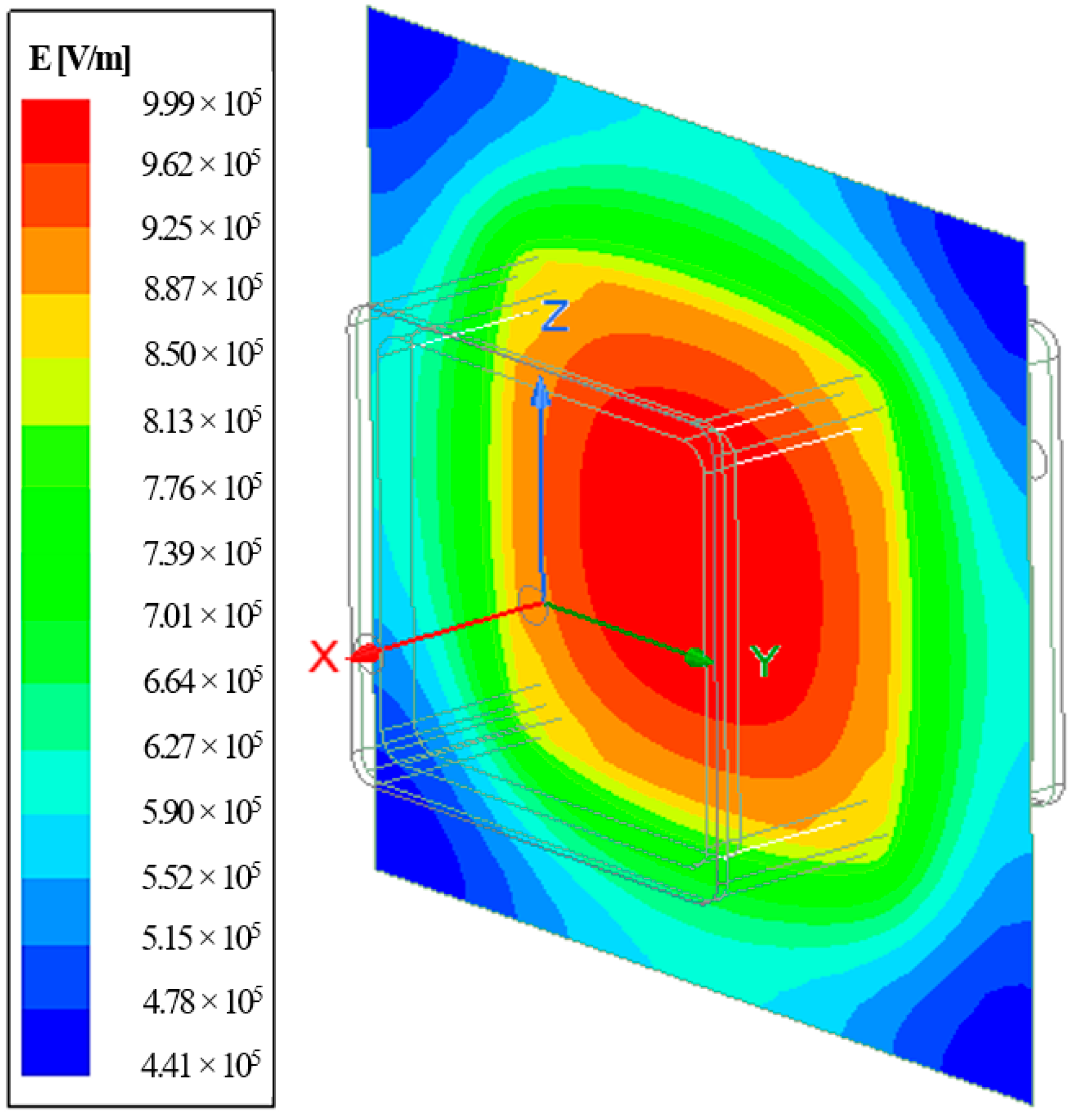
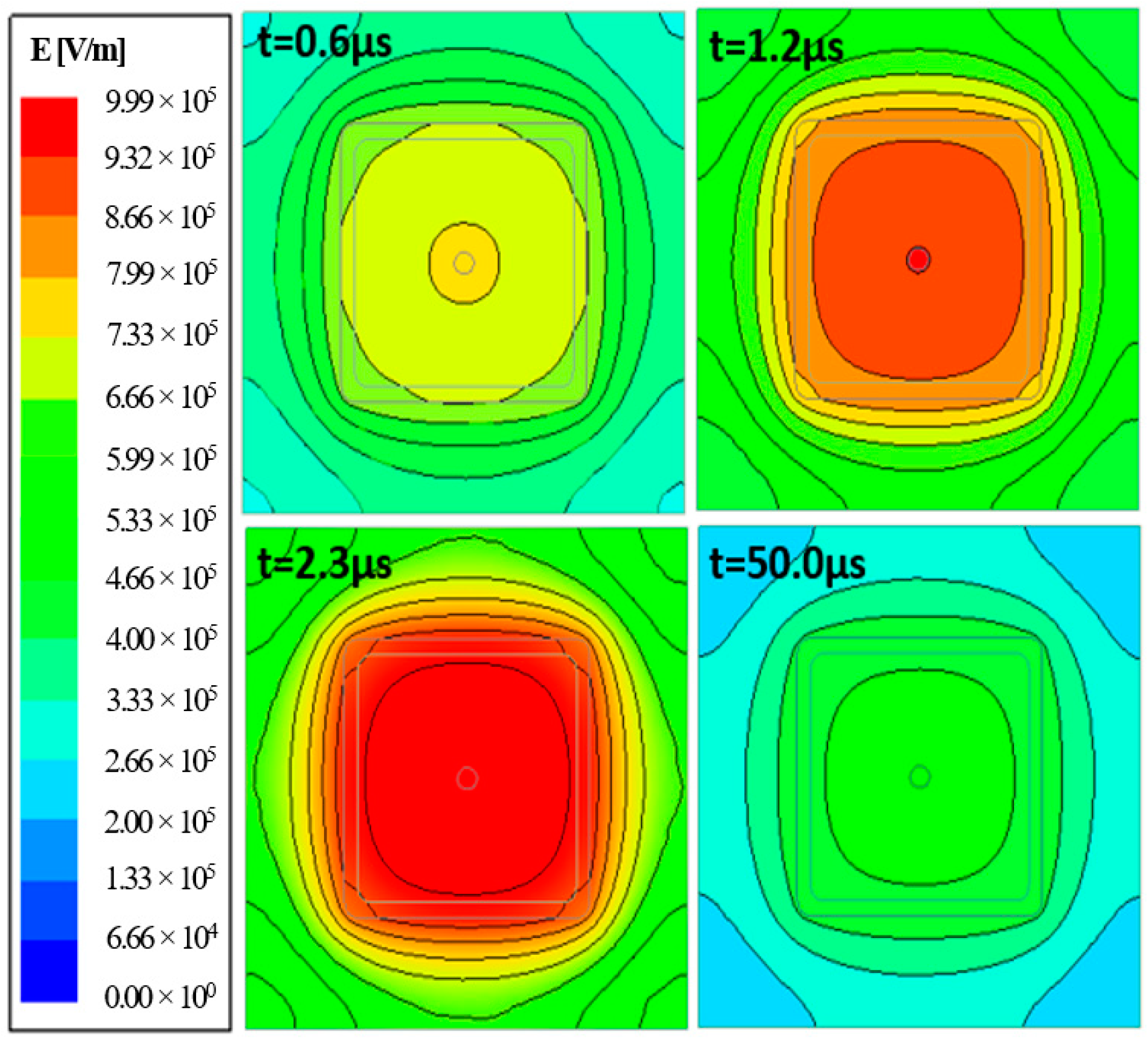
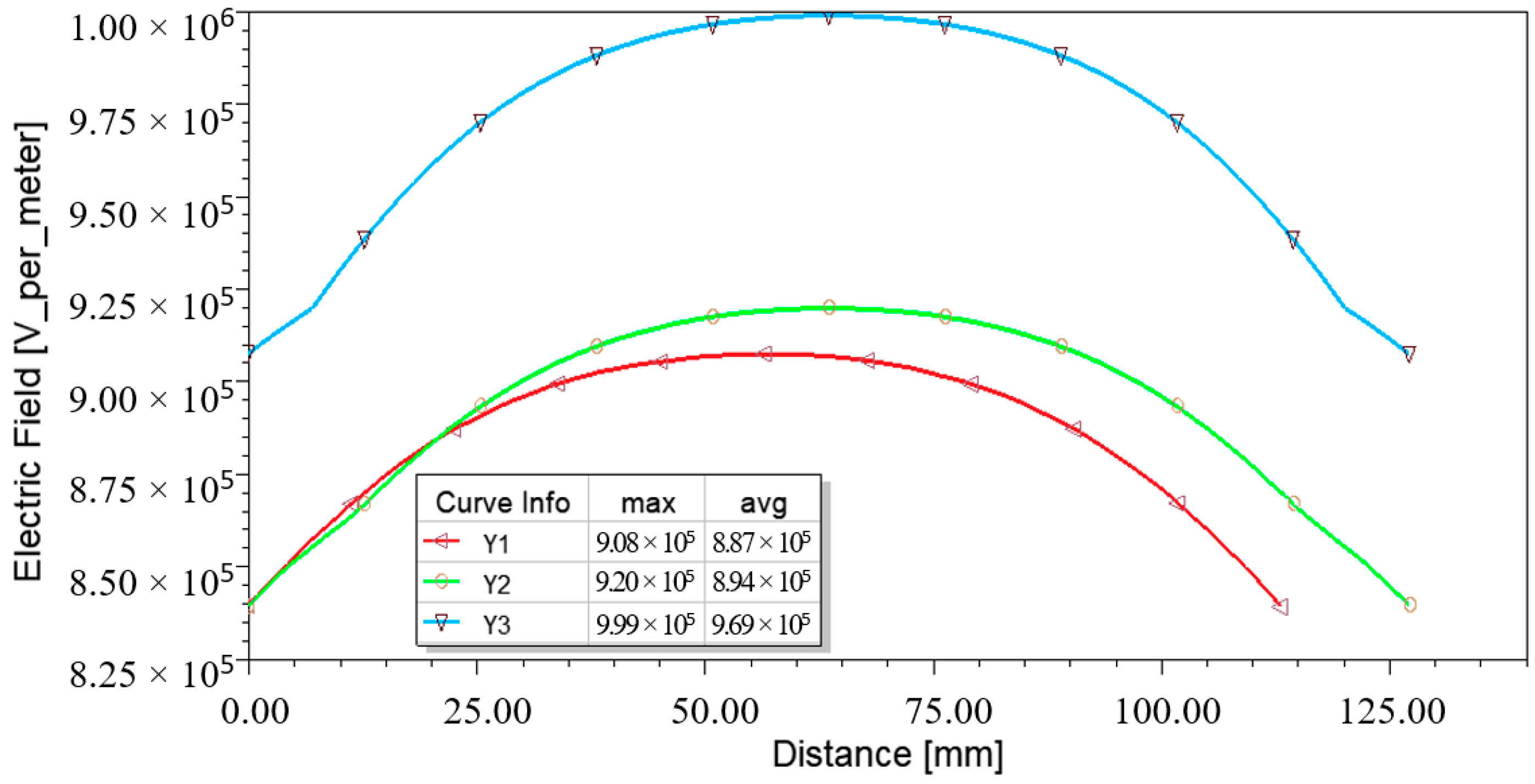
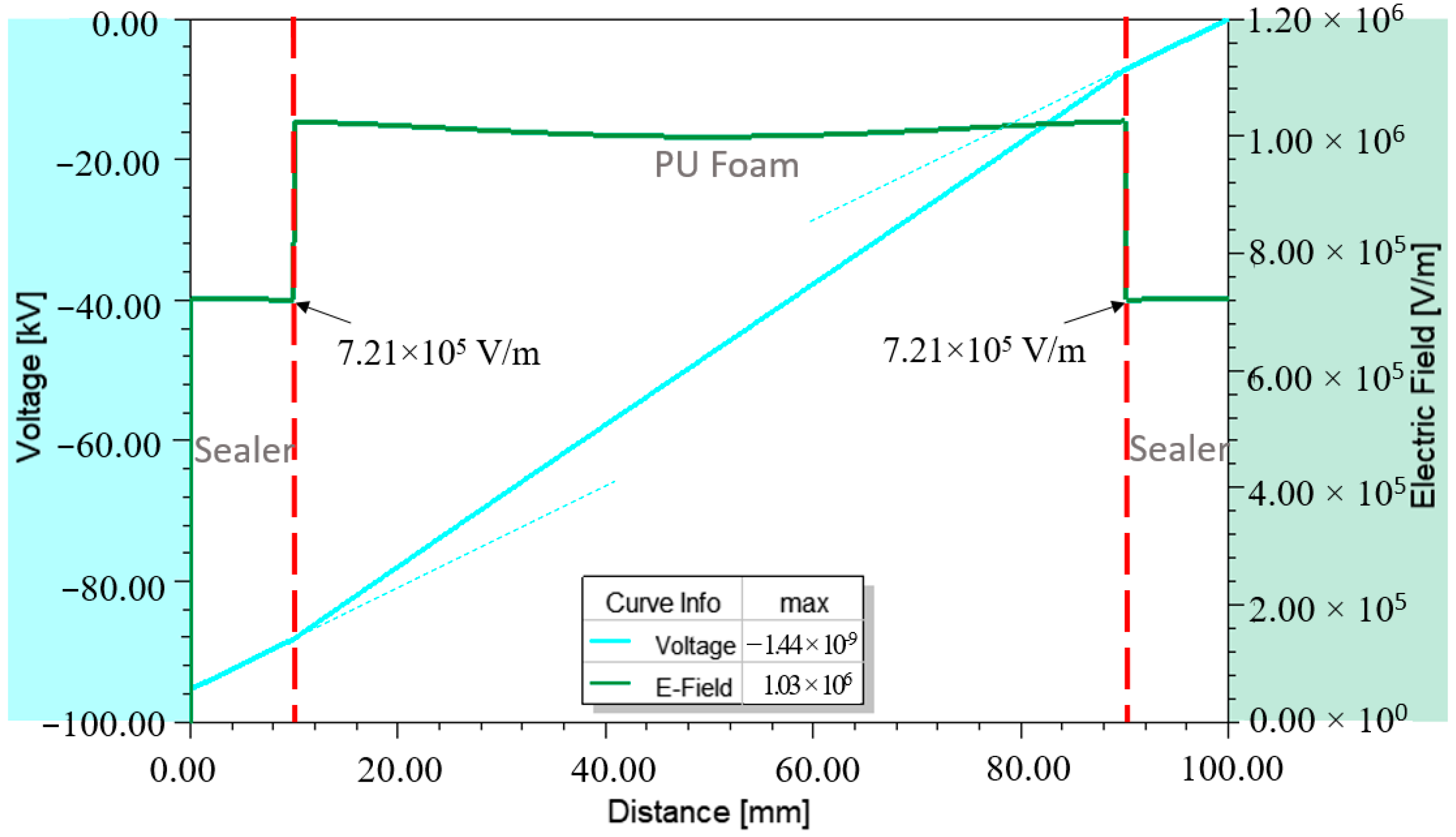
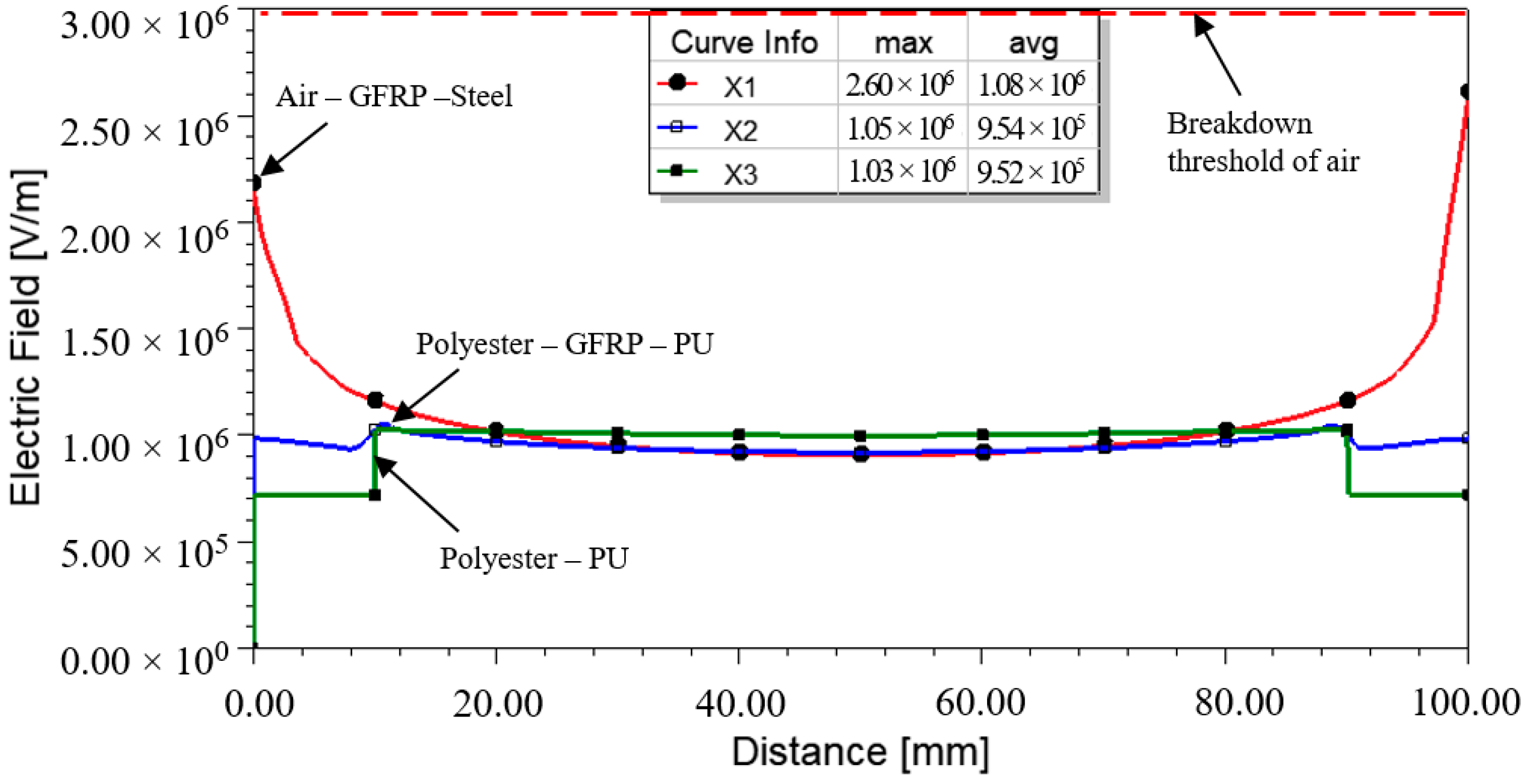
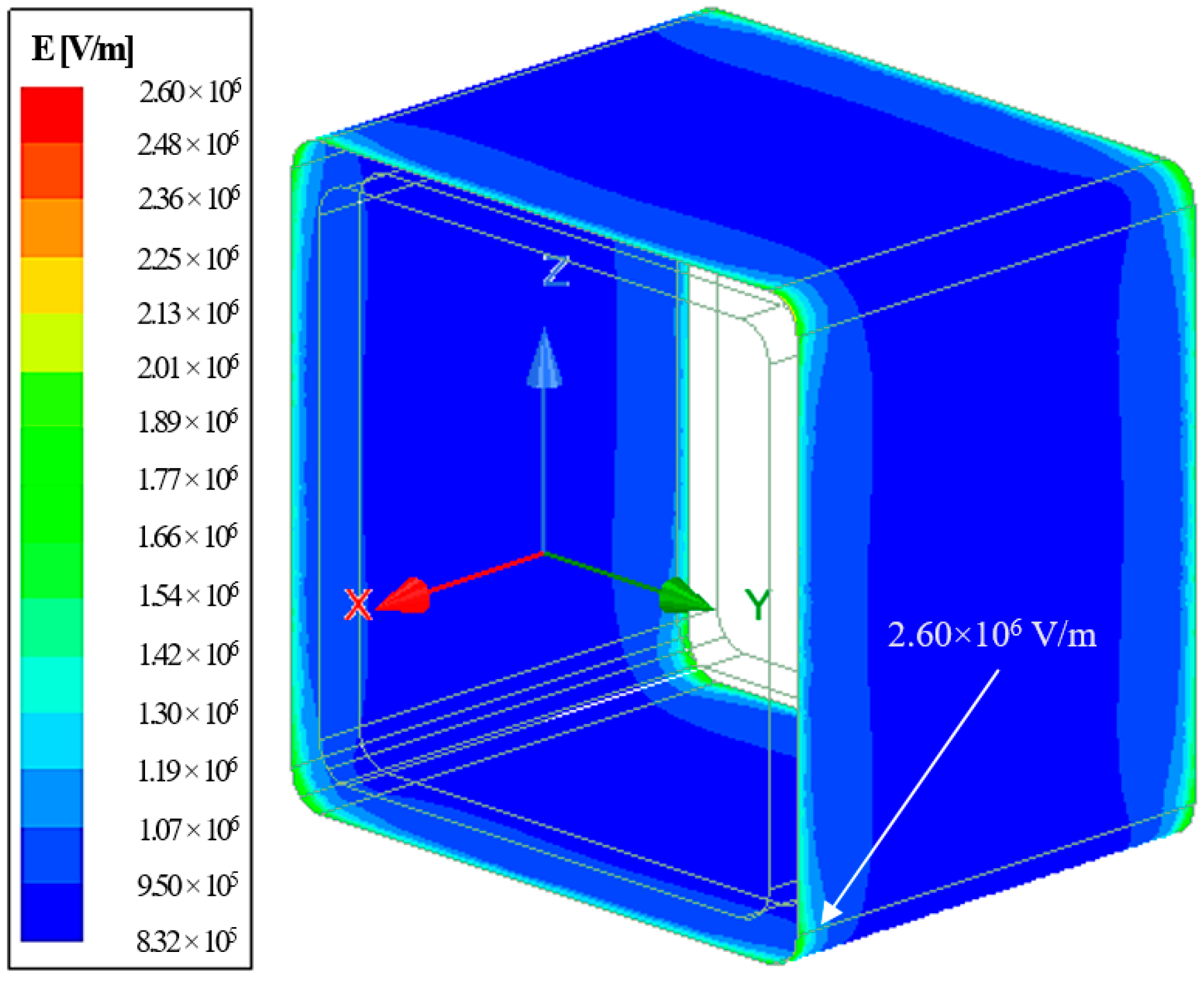
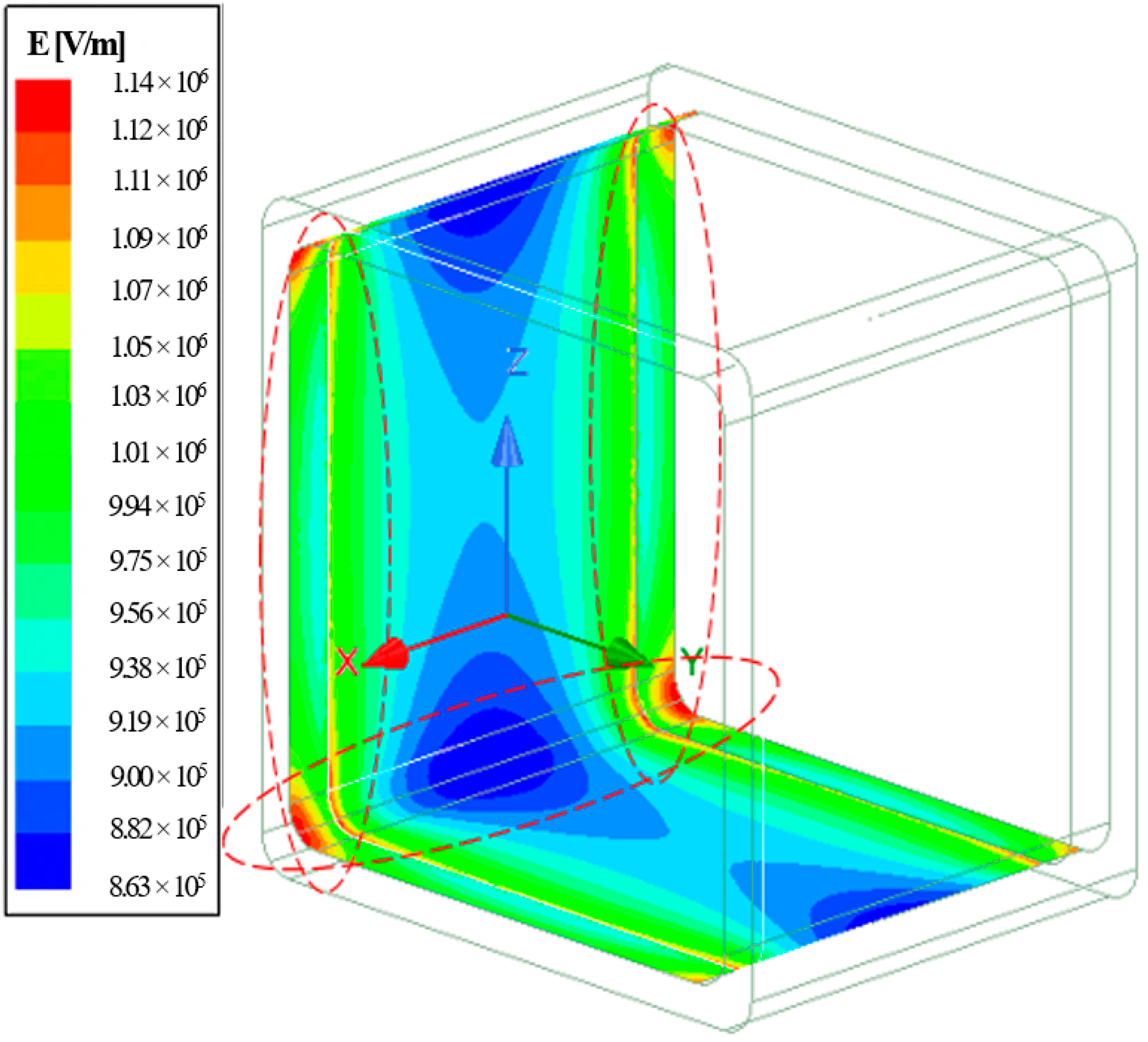
| Parts | Material | Relative Permittivity (ɛr) | Volume Conductivity (σ) S/m | Ref. |
|---|---|---|---|---|
| Air | Air | 1.0006 | 0 | Ansys Lib. |
| Electrodes | Steel | 1.0 | 2.00 × 106 | Ansys Lib. |
| Crossarm | GFRP | 4.6 | 1.11 × 10−14 | [23,24] |
| Foam | Polyurethane | 1.8 | 5.56 × 10−15 | [25] |
| Sealer | Polyester resin | 3.2 | 0 | Ansys Lib. |
| Characteristics | Description |
|---|---|
| Pore Geometry | Spherical |
| Density, g/cm3 | 0.2510 |
| Average Diameter, µm | 200 |
| Pore Porosity, % | 73 |
| Polarity | Sample | CFO Voltage, U50 (kV) | Standard Deviation (± %) | No. of Withstand | No. of Flashover |
|---|---|---|---|---|---|
| Positive | Sample 1 | 85.2 | 3.43 | 10 | 10 |
| 84.6 | 2.43 | 9 | 11 | ||
| 83.9 | 2.84 | 8 | 12 | ||
| Negative | Sample 2 | −94.5 | 1.47 | 10 | 10 |
| −93.7 | 1.81 | 10 | 10 | ||
| −92.6 | 1.59 | 9 | 10 |
Publisher’s Note: MDPI stays neutral with regard to jurisdictional claims in published maps and institutional affiliations. |
© 2021 by the authors. Licensee MDPI, Basel, Switzerland. This article is an open access article distributed under the terms and conditions of the Creative Commons Attribution (CC BY) license (https://creativecommons.org/licenses/by/4.0/).
Share and Cite
Abd Rahman, M.S.; Ab Kadir, M.Z.A.; Abd Rahman, M.S.; Osman, M.; Ungku Amirulddin, U.A.; Mohd Nor, S.F.; Zainuddin, N.M. The Behavior of Polyurethane Foam-Filled Glass-Fiber-Reinforced Polymer Crossarm Subjected to Lightning Transient Voltage. Materials 2021, 14, 5628. https://doi.org/10.3390/ma14195628
Abd Rahman MS, Ab Kadir MZA, Abd Rahman MS, Osman M, Ungku Amirulddin UA, Mohd Nor SF, Zainuddin NM. The Behavior of Polyurethane Foam-Filled Glass-Fiber-Reinforced Polymer Crossarm Subjected to Lightning Transient Voltage. Materials. 2021; 14(19):5628. https://doi.org/10.3390/ma14195628
Chicago/Turabian StyleAbd Rahman, Muhammad Syahmi, Mohd Zainal Abidin Ab Kadir, Muhamad Safwan Abd Rahman, Miszaina Osman, Ungku Anisa Ungku Amirulddin, Shamsul Fahmi Mohd Nor, and Noorlina Mohd Zainuddin. 2021. "The Behavior of Polyurethane Foam-Filled Glass-Fiber-Reinforced Polymer Crossarm Subjected to Lightning Transient Voltage" Materials 14, no. 19: 5628. https://doi.org/10.3390/ma14195628
APA StyleAbd Rahman, M. S., Ab Kadir, M. Z. A., Abd Rahman, M. S., Osman, M., Ungku Amirulddin, U. A., Mohd Nor, S. F., & Zainuddin, N. M. (2021). The Behavior of Polyurethane Foam-Filled Glass-Fiber-Reinforced Polymer Crossarm Subjected to Lightning Transient Voltage. Materials, 14(19), 5628. https://doi.org/10.3390/ma14195628








